We have successfully industrialized fresco, a fruit of Renaissance art, for the first time in the world by developing plaster sheeting and merging the latest pigment ink-jet printing technology. Thus we have succeeded in the reproduction of fresco by using the ink-jet printer.
Fresco Giclee is able to obtain simulated images with natural layers based on digital image data.
This image is created by soaking pigment ink into "unhardened stucco" with light transmission and a unique texture, without the ink development layer like ordinary inkjet paper.
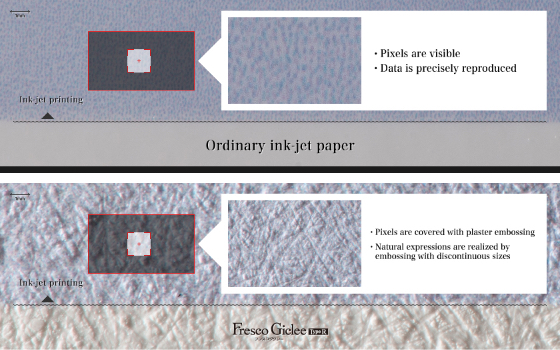
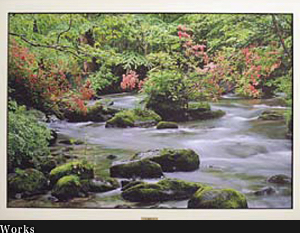
The surface of Fresco Giclee has protrusions of discontinuous size of 50~300μm.
In the case of conventional inkjet media, which has a pixel of about 30 μm, the ink of Fresco Giclee's inkjet printer adheres to the projection and looks as if the protrusion itself has color of discontinuous size.
As a result, unlike the image quality of traditional inkjet media, which uses pigment ink pixels to express colors and has a residual digital feel, Fresco Giclee looks like a fine-brushed painting such as oil painting that pays attention to detail, with a natural sense of layering.

~Expression of color gradation (For example)~
One of the elements of digital perception is that when expressing color layers, such as the sky with subtle changes in hue, there is no continuity in the layers, and some of them appear to be streaked. Fresco Giclee, on the other hand, is able to obtain a natural-looking image with reduced digital perception due to the fact that the ink adheres to the protrusions of discontinuous dimensions, and the "shaking" factor of the stucco texture.
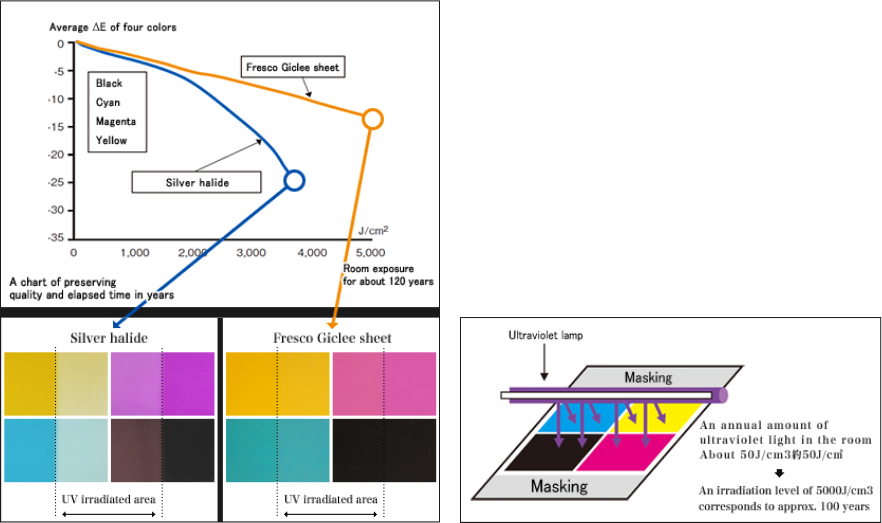
Fresco Giclee is able to obtain simulated images with natural layers based on digital image data.
This image is created by soaking pigment ink into "unhardened stucco" with light transmission and a unique texture, without the ink development layer like ordinary inkjet paper.
Fresco is a plaster-based painting technique used by the Renaissance artists that flourished in Italy from the 14th century to the 16th century, such as Michelangelo and Raphael. Using this technique, an artist would first spread plaster on a wall, and then drew his painting by using pigment colors mixed with water while the plaster was still fresco (fresh), in other words, half hardened.
Fresco is an Italian word for “fresh.”
The famous fresco paintings include the “Last Judgment,” which is displayed on the Sistine Chapel ceiling, painted by Michelangelo in the early 16th century. Thanks to fresco’s mechanism by which pigment colors are contained when the plaster becomes hardened, fresco paintings are preserved without fading even now over 500 years later.
In fresco, first, the entire area is divided into each different painting area that might be drawn on within a day.
Plaster that is kneaded with water is spread on the area to be drawn on within one day. Then the artist starts to draw his painting after the plaster surface has dried, finishing drawing on within the day.
Pigment colors penetrate into the unhardened plaster; afterwards, these pigment colors are contained within the hardening plaster. For this reason, paints used for fresco painting consist of water and pigment colors without binding agent contained.
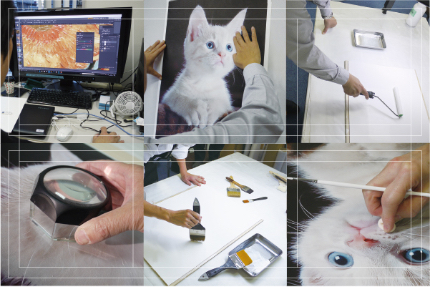
Fresco Giclee was brought forth because we wanted to widely disseminate fresco, what might be called as a fruit of Renaissance art, with our cutting-edge technology.
Why fresco paintings are not produced anymore? It is because fresco is a particular technique by which the artist spreads plaster and draws his painting quickly within a few hours before the plaster becomes hardened. To resolve this issue technically, we developed a technique to make unhardened plaster into sheets. Given this technique, we have successfully revived and brought back fresco into the present with images printed on these sheets by using the latest pigment ink-jet printer.
It takes time for a man to draw a fresco painting. However, this should be a new-generation technique that removes the limitations of time for drawing, which had been the fatal issue of the traditional fresco technique, by using ink-jet printing based on digital data.

・Ink-jet printing sheets for photographers
・Replicas of art museum collections
・Preservation and restoration of cultural properties
Recently, the advancement of digital archives (digital data preservation) has been remarkable in a wide variety of fields of photographs and replicas of cultural properties and paintings.
The texture of Fresco Giclee Type R consists of an endless number of discontinuous-sized projections measuring 50 – 300 μm. Given this texture that can be barely visible by the naked eye, the printed image provides a natural sense of depth that can be seen in those realism paintings.
There is a sister product, Fresco Giclee Type S, that has a texture consisting of projections in sizes that can hardly visible by the naked eye.
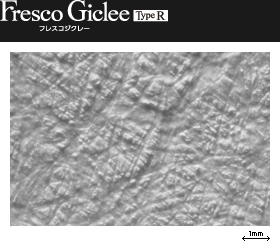
Fresco Giclee is plaster sheeting that is printable by using an ink-jet printer.
We have successfully industrialized fresco, a fruit of Renaissance art, for the first time in the world by developing plaster sheeting and merging the latest pigment ink-jet printing technology. Thus we have succeeded in the reproduction of fresco by using the ink-jet printer.
* Fresco Giclee supports EPSON’s pigment ink-jet printers.
Plaster, which has a texture with fluctuations and light transparency, diffuses light in a complicated fashion. This provides images with a natural sense of depth that can be seen in those realism paintings.
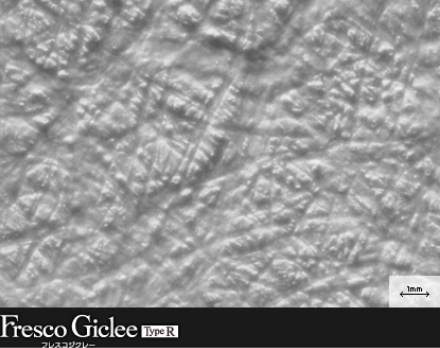
With the texture that is barely visible by the naked eye, the printed image using this product provides a natural sense of depth. Fresco Giclee Type R is the best choice for scenery images.
“R” stands for “rough”.
After being printed out, the plaster gradually becomes hardened. This hardening process takes a few months to a year.
The printed image can be handled the next day.
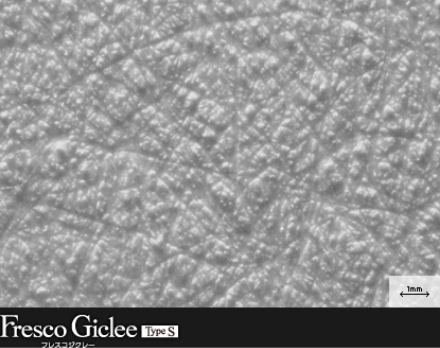
This product has a texture that is hardly visible by the naked eye, providing the printed image with smoothness. With a smoothness which is quite close to that of the human skin texture, this product is best for a sensitive expression of textures such as portraits. “S” stands for “smooth”. After being printed out, hardening progresses gradually and the light resistance (resistance to ultraviolet light) is equal to that of Fresco Giclee Type R.
Plaster is composed mostly of limestone, a natural material, which is the source of its amazing durability.
Limestone is broadly divided into two types: the sediment of calcium carbonate in the ocean and the skeletal fragments transformed into stone.
Limestone is formed slowly and quietly, over generations that seem to be an eternity or forever.
Akiyoshidai in Yamaguchi, Japan, is a typical example. Here, Akiyoshi-do Cavern which is one of the best limestone caves in the entire Orient is located and the largest karst plateau in Japan spreads over 130km2 where huge limestone rocks exist.
This must be the art that can only be brought about by nature.
Limestone rock of good quality obtained from Akiyoshidai is used as the raw material for Fresco Giclee.

To make plaster, first, quicklime is created by burning limestone at 900 to 1000°C, and then made into powdered slake lime by the reaction with water. Next, it is kneaded with mixed water, seaweed, and fibers, and then this powdered slake lime is daubed on a wall and becomes hardened.
Particularly, the finishing fineness of the plaster surface using a trowel really meets the aesthetic sense of the Japanese.
